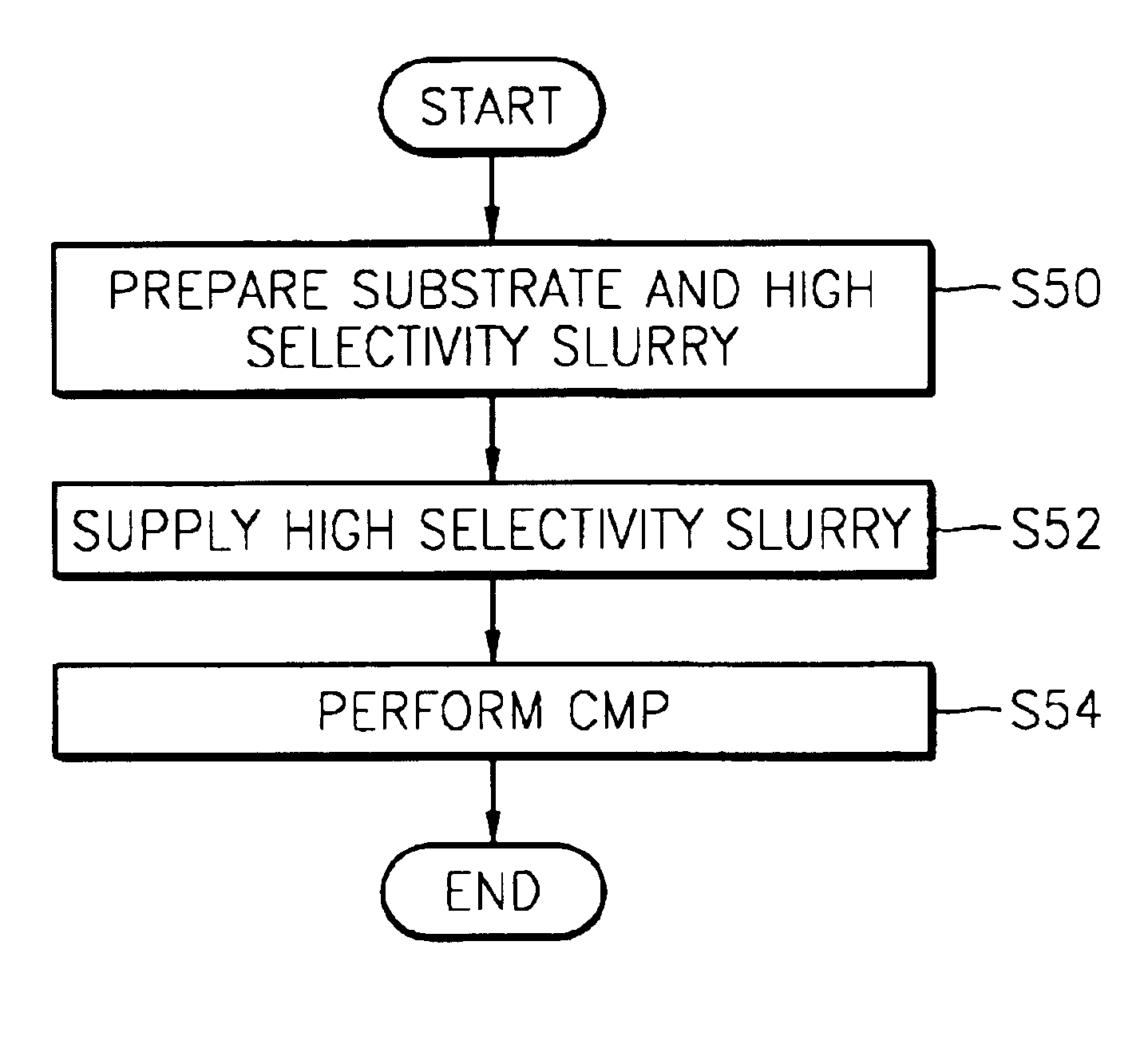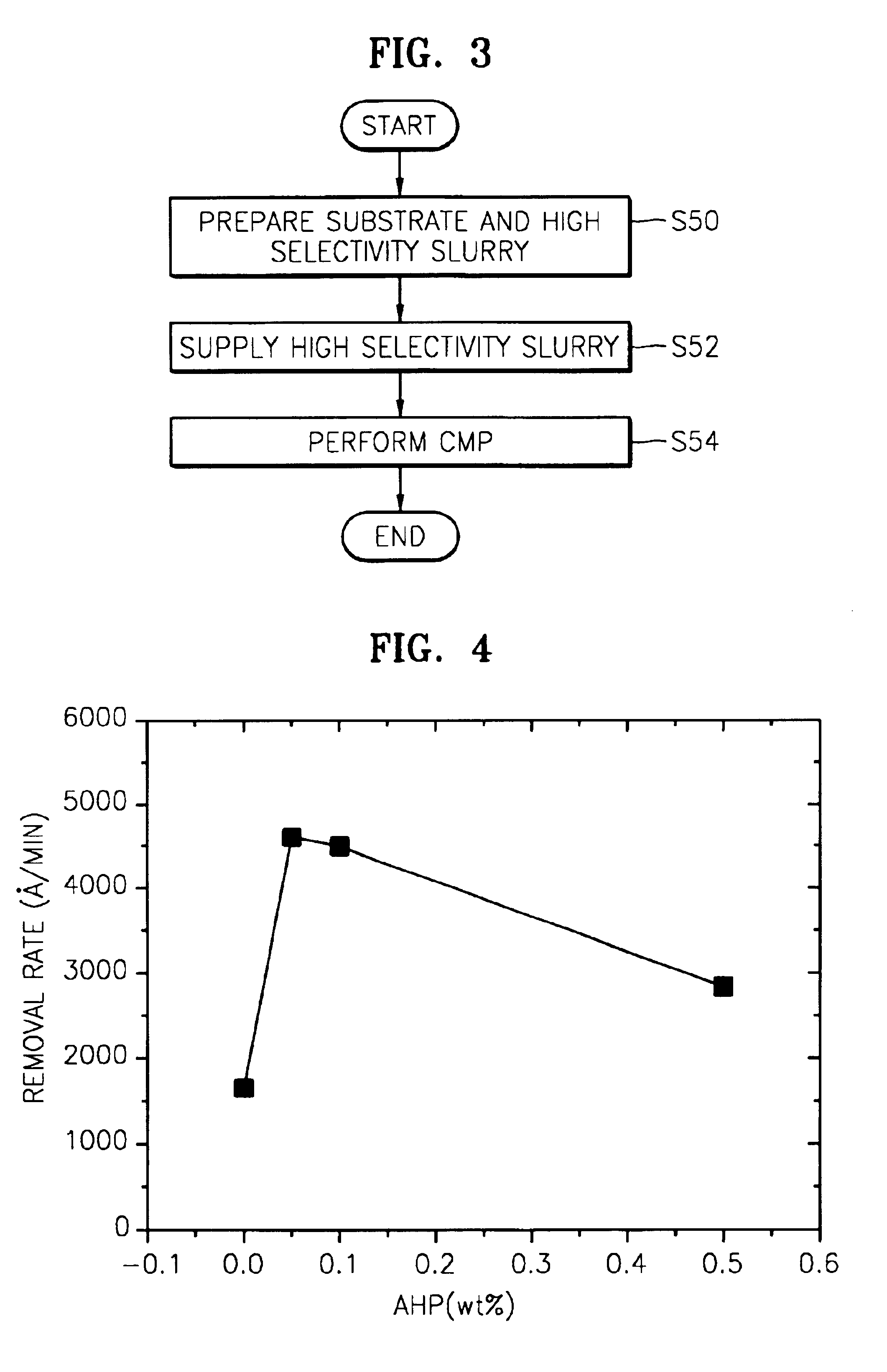Chemical/mechanical polishing slurry and chemical mechanical polishing method using the same
a technology of mechanical polishing and slurry, which is applied in the direction of lapping machines, other chemical processes, polishing compositions, etc., can solve the problems of uneven wafer surface, excessive polishing of polishing stoppers, poor selectivity, etc., and achieves effective passivation of polishing stoppers, high selectivity, and rapid removal of target layers
- Summary
- Abstract
- Description
- Claims
- Application Information
AI Technical Summary
Benefits of technology
Problems solved by technology
Method used
Image
Examples
experimental example 1
In this experiment, based on the method described with respect to FIG. 1, various slurries were prepared by adding ammonium hydrogen phosphate (AHP) as a removal rate accelerator in different amounts to an aqueous solution containing 1 wt % ceria (metal oxide abrasive particles) as a first additive.
PE-TEOS blanket wafers, each having an 8000 Å—thick oxide (PE-TEOS) layer, were prepared as sample wafers.
CMP was then performed on the sample wafers while supplying the slurries containing different amounts of AHP (as shown in Table 1) thereon, and oxide removal rates were measured. The CMP was performed using MIRRA_MESA equipment (RODEL Co., Ltd) under the following conditions: an IC1000 stack pad at a membrane force of 3.5 psi, a retaining ring force of 4.5 psi, an inner tube force of 3.5 psi, a table speed of 110 rpm, a head speed of 104 rpm, and a slurry flow rate of 3000 mL / min. The CMP results are shown in Table 1. FIG. 4 is a graphical illustration of the results.
TABLE 1AHP, wt %O...
experimental example 2
In this experiment, various slurries were prepared by adding 0.25 wt % AHP and different amounts of poly(methacrylic acid) (PMA) as an anionic polymeric passivation agent to an aqueous solution of 1 wt % ceria.
PE-TEOS and silicon nitride (Si3N4) blanket wafers, wherein an oxide (PE-TEOS) layer and a silicon nitride layer were deposited to thicknesses of 8000 Å and 2000 Å, respectively, were prepared as sample wafers.
CMP was performed on the sample wafers while supplying the slurries prepared with the compositions of Table 2, using the same CMP apparatus and under the same operating conditions as in Experimental Example 1. Oxide and silicon nitride removal rates and selectivity were measured during the CMP. The results are shown in Table 2 below. FIG. 5 is a graphical illustration of the results.
TABLE 2Removal rate, Å / minAHP,OxideSilicon nitridewt %PMA, wt %pH(PE-TEOS)(Si3N4)Selectivity0.250.055399310783.7:10.250.1537069753.8:10.250.5524486793.6:10.251516174783.4:1
As can be gleaned f...
experimental example 3
In this experiment, various slurries were prepared by adding 0.2 wt % AHP and different amounts of potassium hydrogen phthalate (PHP) as a C1-C12 anionic passivation agent to an aqueous solution of 1 wt % ceria.
The same sample wafers as in Experimental Example 2 were prepared, and CMP was performed in the same CMP apparatus and under the same operating conditions as in Experimental Example 2. Oxide and silicon nitride removal rates and selectivity were measured during the CMP. The results are shown in Table 3 below. FIG. 6 is a graphical illustration of the results.
TABLE 3Removal rate, Å / minAHP,OxideSilicon nitridewt %PHP, wt %pH(PE-TEOS)(Si3N4)Selectivity00512425422.3:10.205266812062.2:10.20.015261511552.3:10.20.1526688993.0:10.20.25527447723.6:1
As can be gleaned from Table 3 and FIG. 6, as the amount of PHP used as the C1-C12 anionic passivation agent increases, the silicon nitride removal rate decreases. The passivation effect of the anionic passivation agent is evident. Also, in...
PUM
| Property | Measurement | Unit |
|---|---|---|
| pressure | aaaaa | aaaaa |
| flow rate | aaaaa | aaaaa |
| pH | aaaaa | aaaaa |
Abstract
Description
Claims
Application Information
 Login to View More
Login to View More - R&D
- Intellectual Property
- Life Sciences
- Materials
- Tech Scout
- Unparalleled Data Quality
- Higher Quality Content
- 60% Fewer Hallucinations
Browse by: Latest US Patents, China's latest patents, Technical Efficacy Thesaurus, Application Domain, Technology Topic, Popular Technical Reports.
© 2025 PatSnap. All rights reserved.Legal|Privacy policy|Modern Slavery Act Transparency Statement|Sitemap|About US| Contact US: help@patsnap.com



